
Built on the MinCa 18 chassis, and equipped with a pump, water tank, hose, and fire suppression solutions, the fire
truck adopted by Oyo Tolgoi has a pressurized cab that is supplied with breathable air. (Photo: Paus)
Continuously Improving Utility Equipment
Suppliers develop machines with next-generation solutions, engines and technologies
to address the exact needs of customers
By Jesse Morton, Technical Writer

Those same forces have prompted new releases and updated offerings from the other top OEMs in the space. Related headlines summarize the trend among utility equipment suppliers to modify their offerings with the latest design features, solutions, engines, and technologies that answer the most pressing needs of their customers.
Niche Machines Nix
Perplexing Problems
Hermann Paus Maschinenfabrik reported
it sold a mine rescue vehicle configured
as a firefighting unit to Rio Tinto for the
Oyo Tolgoi underground mine in Mongolia.
The first of its kind by the OEM, the
“professional firefighting” unit was co-developed
with Dräger and Rosenbauer to
have “everything you would need on a
firefighting truck,” said Executive Director
Franz-Josef Paus.
Built on the MinCa 18 chassis, the unit is equipped with a pump, water tank, hose, and fire suppression solutions. It has a pressurized cab that is supplied with breathable air to allow the crew to safely drive through contaminated areas without wearing respirators.
The specifications for the design were itemized by the client, said Hendrik Hoernschemeyer, sales manager. “They had an initial need for that because there is no solution available on the market that allows you to drive through contaminated tunnel sections,” he said. “Usually the rescue teams have to take their equipment and walk through the tunnel while wearing respirators and with the clock ticking.” The cabin can be supplied with breathable air for up to 9 hours. The order was placed in 2022 and delivered in Q1 2023. “They are currently going through the commissioning and starting with training,” Hoernschemeyer said. The unit is now central to rescue planning and processes at the mine. “This will significantly reduce the time of any rescue missions.”
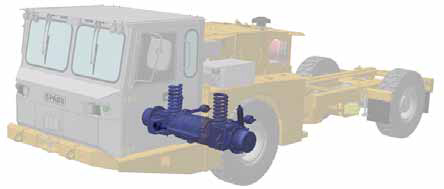
Previously the OEM sold a MRV 9000 vehicle configured as an ambulance to or rescue vehicle to customers in North and Central America. The units featured a pressurized chamber, supplied with breathable air and designed as a specialized man carrier.
Separately, as Hermann Paus Maschinenfabrik nears its 55th anniversary in business, the company is preparing to release the Universa 55 (UNI 55). The evolutionary successor to the popular UNI 50, the carrier can move payloads of up to 17 metric tons (mt) and can be equipped with any of a range of cassettes. “This machine will come with several improvements,” Hoernschemeyer said. “It will have a comfort cab available, several improvements in engine technologies, and interfaces for telemetric solutions.”
With front axle suspension, the carrier offers improved stability over the predecessor model. “That gives a significant improvement in terms of safety when driving at higher speeds on bumpy roads,” he said. The carrier will be equipped with various engines, including one that is Stage V, and can also be designed and developed to be battery powered. The OEM plans to offer units powered by a battery capable of 10,000 loading cycles. “We have aligned battery life with machine life,” Hoernschemeyer said.
The UNI 55 will be offered with a CAN bus system that supports machine monitoring. The system is “a plug-and-play solution that allows the transfer of all the data available from the machine to an external system,” Hoernschemeyer said. “We are using the PAUS Connect Cloud, which is a software solution for visualization and reporting of machine data.” The solution can assimilate and process engine data to generate analytics and failure codes. Both can be used in maintenance planning and reports. “This will be a significant improvement in the management of these machines,” he said. Prototype trials “will start before the end of this year, with release scheduled for the middle of next year,” Paus said.
Hermann Paus Maschinenfabrik also reported it is negotiating with a copper mine in Turkey on a possible order for one or more PTM 100 roadheader units. “They are considering replacing excavators for our higher-performance machine,” said Oliver Wilke, sales manager.
In late 2021, the miner deployed the first unit for production mining applications. Built on a rugged LHD chassis, the rubber-tired unit is compact, for 4-by-4-m galleries. It is 12 m long and 2.2 m wide, and has an enclosed, air-conditioned cab that be lifted up to 600 mm to provide an optimal view. It has a 224-kW QSL9 Cummins engine in Tier III configuration, an 850-mm telescopic boom, and a 160- kW, 1-m-wide transversal hydraulic cutter head. A diagnostics display generates analytics for use in maintenance.
The design of the unit was dictated by the geology of the mine. There, it shears away the surface layer of rock, which is of about 50-megapascal hardness. The rock is then mucked out. “It is a hard rock mine, but there are a lot of cracks and faults in the deposit,” Wilke said. “That was the reason why they couldn’t actually use more heavy roadheader machines, due to the stability of the ground.”
The only one in existence, the unit has operated near “perfectly” since deployment, requiring only the scheduled maintenance, he said. “The customer is absolutely happy about the performance.” The topmost benefits offered include the capability to swiftly go from face to face through relatively small drifts. “That is the big advantage of rubber-tired vehicles,” Paus said. “You can immediately go from one site to another with very little time consumed,” he said. “Tracked machines, like roadheaders or excavators, will take much more time to move from one face to another.” The unit provides “a safer alternative to drilling and blasting,” he said. “We know there are other miners that might be interested in this kind of machine.”
The OEM currently is in the preliminary stages of designing updates to the MinCa 18. “We have been pretty busy with the UNI at this time,” Paus said. “We may have a more clear vision for the Min- Ca 18 by Q4 this year,” he said. “But we have to wait until then.”
Customizable Land Cruiser
Cuts Costs
Miller Technology Inc. reported it sold out
of the first and second run of the Land
Cruiser with a Cummins ISF2.8 engine. A
total of 70 units were produced and were
sold by Classic Motors of Richfield, Utah,
U.S.A., to American mines.
“We’ve seen a fantastic first run of
production thanks to Joe Betar and his
team,” said Hugh McDermid, vice president,
operations, Miller Technology. “We
are working with the folks at Cummins to
secure more engines as soon as possible
to be able to schedule a third production
run of these units.”
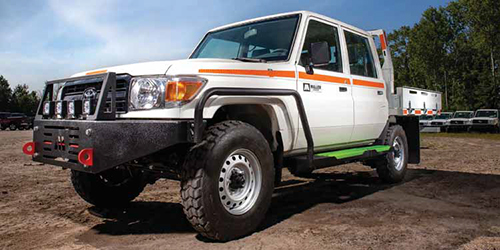
Miller Technology supplies up to 400 or more Land Cruisers per year. There are vast populations of the unit in Australia and Canada. Up until now, it wasn’t available with a U.S.A Mine Safety and Health Administration (MSHA)-approved engine. Beyond meeting regulations, the new engine is capable of supporting remote monitoring and other digital solutions.
“We have added some functionalities above and beyond what the standard Land Cruiser was traditionally able to offer,” McDermid said. “We have updated the user interface inside the vehicle.” That will allow customers to “see any of the fault codes being driven from the powertrain control module, right on the dashboard,” he said. “It will lead to easier diagnosis of the vehicle during use if problems do arise.” The engine will also support the “integration of any number of electronic addons that we have available,” McDermid said. “We can have vehicle monitoring and remote diagnostics. We can have the vehicle embedded with RFID tags to improve safety and give operators a better idea of how and where their vehicles are being used.”
Historically, Miller Technology has seen high demand for the Land Cruiser due to its “ease of serviceability, the robustness of the drive frame, suspension, and body work, which is not comparable to anything else on the market,” he said. The unit is versatile and customizable, and the supplier offers a range of configurations and cassettes. “We have everything from a simple pickup box flat-deck, a mechanics arrangement for mechanics’ servicing underground equipment, personnel transport, elevated work platform, and we are also always open to customer requirements based on customer needs,” McDermid said.
The supplier partnered with Classic Motors to distribute the unit because “they have a wealth of knowledge that is pertinent to any of the mining customers in their territory,” he said. “They are a great outfit, a great group of people that are able to sell, service and support these vehicles throughout the United States.” Classic Motors has previously specialized in the design, manufacture, sales, and service of underground mining utility vehicles based on the Ram truck and the Jeep J8, the company said. “Now, CMI is replacing those vehicles with a new utility vehicle based on the Land Cruiser,” said owner Joe Betar.
The unit “is the choice of mine operators throughout the world,” he said. “CMI is teaming up its expertise in the U.S. mining market with the engineering prowess of Miller Technology, one of Canada’s mining leaders, and add in the proven reliability of the MSHA-approved Cummins 2.8-L Turbo Diesel, to get an unbeatable package that is easy to maintain and affordable to purchase.” Inquiries for sales, service or support should be made to Classic Motors, Mc- Dermid said. “From there, Classic Motors and Miller Technology will work together to develop specific requirements for the end user.”
Mid-size Multi-Lift
Diversifies Lineup
MacLean Engineering released the ML5
Multi-Lift elevated work platform. The
model was purpose built for mine services
installation applications and repair work
applications. Originally for operations in
Australia, it is a mid-sized machine and
strengthens the OEM’s portfolio of elevated
work platform solutions, MacLean said.
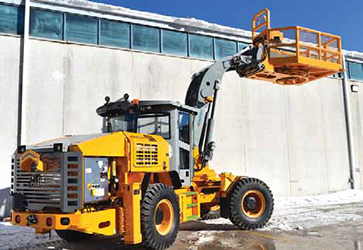
Engineered “for safety, productivity, and versatility,” the ML5 is “a certified elevated work platform with a 6.5-m working height and a 2.25-metric ton (mt) payload,” MacLean said. With an attachment instead of the basket, that capacity doubles, said Bryson Lehman, product manager, utility vehicles, MacLean. “The working height of this machine is 4.5 m to the deck of the basket,” Lehman said. “It has an about 6.5-m working range,” he said. “This machine also has a boom swing of plus or minus 30°.”
That gives a roughly 6-m-wide face coverage. The OEM describes that coverage as “best in class.” Lehman describes it as boosting productivity. “With the boom slew you have a greater range of motion, so you can reach more areas from one setup.” Height to the top of the cab is 3.2 m. It is 2.4 m wide. “In size, it is the equivalent of a Volvo or a Cat wheel loader,” Lehman said. The model has a 2-person cab. “There is lots of glass so you have good sight lines,” Lehman said. “There is excellent visibility with it.” Heat and air conditioning is available, as are other standard options.
The model belongs to “what we call our 5 Series, which have an updated control system,” he said. “We are using the latest and greatest MacLean operating system.” The system has advanced capabilities. For example, it can sense the orientation of the machine, and alert the operator to a potentially unsafe setup. “Being an elevated work platform, stability is a big focus,” Lehman said. “The other big technology feature on this machine is what we call the drive-bywire system,” he said. “Rather than using a conventional steering wheel and pedals, it is all controlled through the joystick.”
The machine is driven using two joysticks on the seat. The boom and basket are operated using in-basket controls. “There is no need for another operator to sit in the cab to operate the boom,” Lehman said. “It is all self-contained within the basket,” he said. “Operation- wise it is a mimic of what you see in the actual cab, same movement, same everything.”
The ML5 also features MacLean’s remote drive system, or RDS. “This is actually driving the basket,” Lehman said. “It is a big productivity feature,” he said. “The RDS helps by having small controls within the basket so that you can move that machine along and you don’t have to lower the basket to the ground or get into the operator cab to move yourself five feet.”
“We can’t wait to see this first unit arrive in Australia in Q2,” said Jari Tuorila, general manager, Australasia, MacLean. “This continues the MacLean tradition of designing mobile equipment solutions for one particular part of the underground mining world, which are then taken around the globe to solve similar problems at different operations.”
Versatile Telehandlers
Offer Reliability
Getman Corp. added the Series 9 and
Series 10 Telehandlers to its product portfolio. “The base product is already
well-established in surface construction
applications, and has been refined
by Getman for underground applications,”
said Christopher Warner, product
manager.
The Getman telehandlers “are defined by their rugged design and reliability,” Warner said. “They feature superior machine and boom stability, are flexible and agile, and offer good visibility for greater safety.” Both models are roughly 7 m long, 2.7 m high, 2.6 m wide, and have a turning radius of 4.3 m. “The Series 9 units have a lift capacity of 4 mt and a maximum lift of 13.5 m,” Warner said. “And the Series 10 units have a lift capacity of 4.5 mt and a maximum lift of 14.1 m.” Two engines are offered: an 87-kW, Tier 4-Final Cummins turbo diesel with DOC muffler; or an 89-kW, MSHA/CANMET- listed Deutz Tier 3 engine.
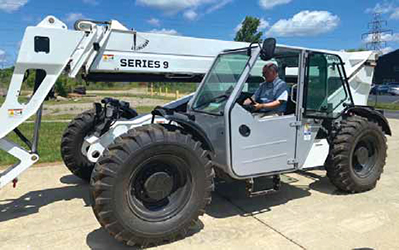
Robot Cuts Labor
Requirements
Brokk reported the Brokk 200 demolition
robot is ideal for zero-emission, ultra-
deep mining applications.
“Our remote-controlled demolition machines help through remote-operation, compact power and equipment versatility,” said Raymond Ippersiel, North American training and application specialist, and sales manager, Brokk. “These machines offer high productivity and increased safety compared to manual methods, so operations are better able to protect and utilize their workforce.
Described as “a compact masterpiece with incredible strength and reach,” the robot weighs roughly 2.1 mt, is 780 mm wide, 1.3 m tall, and has a horizontal reach of 5.1 m and a vertical reach of 5.5 m. It is electric, has a threepart arm, and incorporates Brokk’s SmartConcept system.
Going back to the first Brokk machine announced in 1976, all Brokk robots are electric. “We spent the last few decades developing the most effi- cient ways to use electric power without sacrificing hitting power,” Ippersiel said. “The electric power sources guarantee zero-emission operation.”
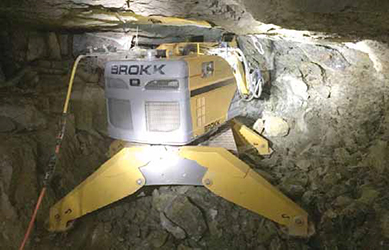
“With the multitask versatility of Brokk demolition machines, operations can streamline work by easily switching attachments to shift from drilling to breaking to scaling,” Ippersiel said. “Thanks to advances in technology, these machines can also handle much larger attachments than similarly sized machines.”
Bigger attachments mean the operator can complete a drilling, breaking or scaling task without getting within 4 m of the work surface. “While the operator stands a safe distance away, the machine can drill, load a rock bolt, then torque it without any wasted movement for fast, efficient, safe working conditions,” he said.
The Brokk 200 uses the SmartConcept system, which gives improved performance and uptime. The system is comprised of SmartPower, SmartDesign and SmartRemote. “SmartPower senses when the power supply is poor or faulty then compensates before damage to components occurs,” Ippersiel said. “This allows operators to use the machine with generators or unreliable power sources.”
SmartDesign uses 70% fewer cables, hardened components, LED headlights and easily accessible grease points and hydraulic hoses. The robot uses hydraulics that eliminate the “need for supplying compressed air, which, in turn, minimizes the utility requirements in the mine,” he said. “An ergonomic remote control, the SmartRemote incorporates adjustable straps, intuitive controls and professional- grade radio technology with a 300-m working range,” Ippersiel said.
These features combine to offer superior performance compared to competitor machines, reduced staffing requirements, and improvements in safety. “All Brokk demolition machines offer exceptional power-to-weight ratios, often on par with machines three times their size, and significantly outclass even the most advanced jackleg drills,” Ippersiel said.
Replacing jackleg drills and other handheld equipment with a Brokk eliminates the need for a large crew. Usually, only a single operator is required. “The Brokk 200, or any of our other machines, helps to eliminate the need for so much physical labor so miners can get by with smaller crew sizes when necessary,” Ippersiel said. “The elimination of physical labor translates into increased and consistent productivity over time with the same hitting power and speed over the course of an 8-hour shift.”
The efficiency increases can help cut costs. “One mine employing demolition machines has seen costs per linear meter go down by 60% from conventional manual methods,” he said. “One operation using Brokk demolition machines to open older shafts doubled their monthly linear output while reducing labor requirements by 44%.” A third operation used a Brokk demolition robot to eliminate all manual labor in a shotcrete removal application. The move “advanced their maintenance schedule by months,” he said. “They positioned the Brokk on a platform that rotated around a shaft boring machine,” Ippersiel said. “After the shotcrete was removed, they used the machine to pin and bolt new screening.”
New operators require minimal training, which also helps to reduce costs. “Our designers use end user feedback to make our machines easy to master and capable of all manner of projects without limits,” he said. The most critical benefit offered is safety gains. “Remote-controlled demolition equipment has an operating distance of up to 300 m to keep employees distanced from falling rock, harmful vibrations, sprained backs, pinched fingers and unsafe noise levels,” Ippersiel said. “For the Brokk Pedestal Boom, we also offer Networked Remote Operation,” he said.
“This solution allows an operator to control the machine while sitting in a control room,” Ippersiel said. “Depending on the network configuration, the machine can be maneuvered from 2,000 m away or further.” That means fewer injuries and subsequent costs. “Remote operation paired with smaller crew size can significantly lower any worker liability costs by limiting personnel on hazardous operations,” he said. “Working with Brokk to mechanize mining and maintenance solutions promises to improve not only current productivity, but ensure a safer, more sustainable future for mining operations.”